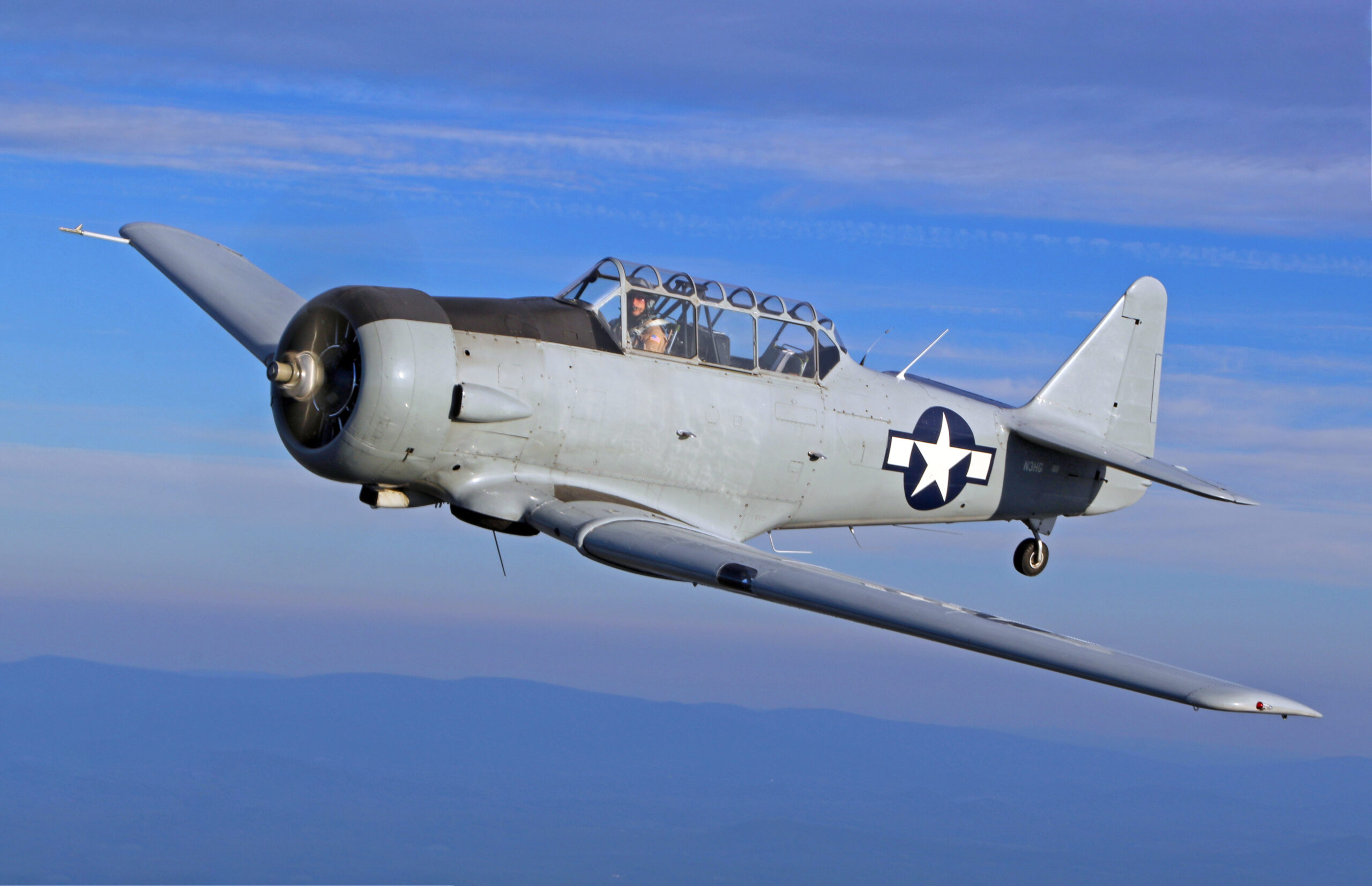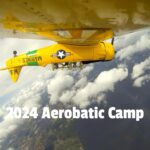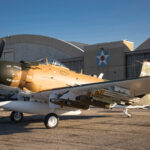In recent years there has been a push to recognize individuals under 40 years old for their contributions to the warbird community. The most prominent program is the Warbirds 20 under 40, which was originally developed by Mark Clark and Darcy Kapke of Courtesy Aircraft Sales and introduced at the 2019 National Warbird Operators Conference (NWOC). Naturally, getting the younger generations interested and involved in warbirds is the key to survival of the community and when they do, they deserve recognition. At AirVenture 2024, this program was re-introduced with twenty individuals being named and honored. However, there are many others out there that have worked hard to climb the warbird ladder and are primed to take the reigns as leaders in the warbird community and one such pilot is Johnny Mazza III, who is a third generation pilot and flies with the Military Aviation Museum (MAM) in Pungo, Virginia.

Johnny’s grandfather was a forward air controller in World War II, and his father John “Pappy” Mazza, flew O-2s in the Virginia Army National Guard and was once very active in airshow aerobatics. Today, the Mazzas fly a number of aircraft, including a pair of Texans, out of their private airstrip near Richmond, Virginia. In a recent interview with Vintage Aviation News (VAN) Johnny shared his early aviation memories. “I’ve been flying literally since I was born. I don’t know how old I was, but I vaguely remember my dad and grandfather taxiing around in a Cessna 310 we had across the street at our field. When I was five or six, they stacked cushions on the seat of our Ercoupe, so I could see over the instrument panel.”

The Mazzas own and operate a very successful pool business and fly their Piper Cheyenne to their dealers and distributors across the country, so Johnny never had any aspirations of becoming a professional pilot. “I just enjoyed doing it just for the thrill of it and the love of it, not to pay the bills.” Johnny related. While Johnny enjoyed flying throughout his youth and adolescence, it wasn’t until after his father, Pappy, purchased Walt Ohlrich’s famous SNJ-5 known simply as 502 that he started flying heavy tailwheel warbirds, which led to the purchase of his own “Pilot Maker,” a 1949 T-6G, in 2013.

By the time Johnny got his T-6, Pappy had started flying with MAM, and Johnny made that his goal as well. He said, “There was no question that I wanted to fly for the museum, but back then I didn’t have the hours that I needed, so I started building time, especially in the T-6, and hanging out at the museum. I wasn’t technically a pilot there, but they would invite me to events with my T-6. Flying with the museum is more than about having the required hours. Johnny continued, “…they also want to see if this a guy we’re going to want to go to the air shows with and hang out with for a weekend. I started going down there in 2010 or ’11 with the Yak-50, but when I got my T-6, I was down there a lot helping out with whatever they needed.” Johnny’s perseverance finally paid off in 2017, when he was invited to join the cadre of pilots at MAM.

Johnny first started flying the Stearman, but soon checked out in the P-64, an aircraft he thoroughly enjoys. “A lot of people don’t like it because it’s a converted T-6. But it’s a T-6 with 1,200 horsepower, so you have double the horsepower. In a T-6, I don’t care what you do, realistically, normal conditions, you might get 140 knots. That P-64 will cruise around all day at 180, 190 knots. It’s a rocket. Below 10,000 feet, it’ll keep up with any of the fighters. It is honestly one of the most fun airplanes I’ve ever flown.”
After flying the P-64 for a year or so, MAM Chief Pilot Mike Spalding came to him one day and asked if he wanted to check out in the Skyraider. The AD-4 Skyraider, BuNo 123827, at MAM is no ordinary warbird, but an incredibly historic aircraft. After rolling off the Douglas El Segundo production line on September 29, 1949, and less than a year later it was aboard USS Valley Forge (CV-45) with Attack Squadron Fifty-Five (VA-55) Torpcats when the Communists stormed across Korea’s 38th Parallel on June 25, 1950. Six days later, Valley Forge launched the Navy’s first carrier-borne airstrikes of the war and VA-55 Skyraiders attacked airfields in Pyongyang, North Korea, destroying hangars, aircraft, and fuel depots. This mission marked the combat debut of the Douglas Skyraider and 123827 was in the thick of the fight.
In the fall of 1953, the aircraft was attached VA-75 Sunday Punchers when the squadron sailed into the North Atlantic aboard USS Bennington (CV-20), where it would participate in Operation Mariner along with USS Wasp (CV-16), and Canadian carrier HMCS Magnificent. On September 23, 1953, ‘827 and 41 other aircraft were nearly lost when they were launched into marginal weather conditions at 1330hrs. An hour later all three carriers were enveloped in a heavy fog and zero-zero conditions. This stranded 32 aircraft, including ‘827, aloft with dwindling fuel. The situation became so dire that pilots asked for Last Rights over the radio.

Then suddenly there was a small break in the fog, and all aircraft managed to get aboard a carrier, even if it wasn’t their own. Fifteen minutes after the last aircraft recovered the fog descended once again and the task force sailed in zero-zero conditions for the next 18 hours. The prayers offered in the preceding hours had been answered, and the event became known as The Mariner Miracle. The final duty station for ‘827 was NAS Atlanta where it was stricken on July 25, 1956, with 2,807 hours total time. Like so many warbirds flying today, the MAM Skyraider fell into disrepair at DeKalb-Peachtree Airport (PDK), until it was saved by PDK employee and former USN Skyraider electrician Dave Forrest in 1966. After a 12-year restoration Dave took his AD-4 aloft on its first post-restoration flight on December 5, 1978. Over the next several years Dave put 200 hours on the airplane flying it to various airshows throughout the southeast. In August 2000, the Skyraider joined the Fighter Factory, as MAM was once called, still wearing its Atlanta markings. In 2001, the aircraft was repainted to represent the AD-4 flown by VA-195 CO LCdr Harold ‘Swede’ Carlson on the famous Hwachon Dam raid on May 1, 1951.
Given this amazing provenance coupled with the fact that the Skyraider is the largest single-engine aircraft in MAM’s collection, Johnny jumped at the chance to fly the venerable Able Dog. He would have to wait however, as he related, “When I told Mike I’d love to fly the AD, he said, ‘All right. As soon as the weather gets right,’ because during the winter months down there, that runway gets soft. It just doesn’t dry out. The Skyraider is so heavy that it would quickly sink, especially the tailwheel. So, they gave me all the material and I started reading and studying. Once I knew the airplane inside and out, I just had to wait on the runway.” This was in 2019, and the calendar was getting into mid-April and the runway was still too soft and Johnny was worried that he might not get checked out in time for the annual Warbirds Over the Beach Airshow, which was then held in mid-May. Then the call finally came, “Mike called, ‘Hey, can you make it down we start doing this Skyraider check out?’ I went down the first day, and we basically did a ground school. He talked about little quirks, what to do, what not to do, what to expect, that sort of thing. Then we went over the cockpit. He showed me everything, starting procedures and all. I came back down a few days later and we did start-up and taxiing. Then he asked, ‘Do you feel comfortable?’ I said, “Yes.” He said, ‘Go ahead.'”

“When I got to the end of the runway, I felt confident, but I literally went through everything three, four times. By the time I was ready to go there were like fifteen mechanics and volunteers out on the ramp to watch. With 3,000 horsepower, you can’t just give it full throttle because it’ll run you off the runway. So, I ran it up to 30 inches that first time and released the brakes. I started giving it power as it’s rolling. I was prepared for the torque because people told me about it, but I was pushing as hard as I could to keep it straight. Before I even knew it, the plane was off the ground. It was that fast.” Just like any other solo flight, Mike wanted Johnny to do three take-offs and landings. Once those were done, he taxied in and shut down, and Mike asked him what he thought. “Three thousand horsepower and one seat? It’s awesome!” Johnny replied. Prior to Johnny’s checkout in the AD, the aircraft was flown mostly by former A-6 pilot Kevin Sinabaldi and after Johnny’s flight the senior pilots started joking with Kevin that “Johnny’s taking your airplane.” Today, Johnny and Kevin basically have the Skyraider to themselves and when another pilot expresses an interest in checking out in the beastly AD, the duo jokingly say, “You don’t want to fly this airplane, it’s a piece of s**t.”
In that first summer as the world’s newest Skyraider pilot, Johnny had an experience that every warbird pilots relishes: meeting a veteran who flew the type in operational service. During the summer months, MAM holds flight demonstrations on Saturdays where they pull an aircraft out for a flying display. One Saturday, Johnny was scheduled to fly the Skyraider when he was approached by one of the museum volunteers. “He told me there was a Skyraider veteran coming to speak. I said, ‘That’s great and I got a Skyraider.’ The volunteer was like, ‘You don’t get it. He didn’t fly any Skyraider. He flew this [the museum’s] Skyraider.’ He had his logbook with him, and it showed that he flew the museum’s Skyraider in 1952. He had one entry that said he came back to the carrier with 167 holes in the airplane.” The veteran, 92-year-old John Lavra, CAPT (USN), Ret., enlisted in the Navy in June 1944, served as a combat aircrewman during World War II, and earned his commission and Naval Aviator Wings on October 10, 1947. During his career, Capt. Lavra logged 5,300 flight hours, 365 carrier landings on five aircraft carriers in twenty-two aircraft models. His combat tours included anti-submarine operations in the South Atlantic and Caribbean, two tours in Korea, and logistic support missions in and out of Chu Lai and DaNang during Vietnam. He retired on November 1, 1970, with numerous medals, including Purple Heart, Air Medal with two gold stars, and the Navy Commendation Medal with combat “V,” among others.

During the event at MAM on June 9, 2019, Capt. Lavra obviously spoke of his experiences flying ADs with VA-55 aboard USS Essex (CV-9) during Korea, including being shot down on October 20, 1952. On that day his squadron was tasked with attacking the Kojo hydroelectric plant deep inside North Korea. Once they arrived over the target at 12,000 feet, Lavra rolled into a glide bombing attack with his section leader. They released their bombs at 5,000 feet and as Lavra was pulling out of the attack he “…felt a terrific wrenching movement and sound…” followed by “…a terrific fire in the cockpit.” The Skyraider was whipped into a violent spin and Lavra had to reach into the fire to find and pull the canopy release. By the time he struggled to get out of the cockpit and search for and pull the D-ring on his parachute, the AD-4 had spun below 1,000 feet. Lavra, despite sustaining severe burns in the spin, was still able to conceal himself from nearby enemy soldiers, perform first aid on himself, and get himself into the sling lowered by a Sikorsky H-5 helicopter.
After climbing down from the cockpit after the demo, Johnny chatted with Capt. Lavra, “He was the coolest guy. Cool as can be. Another of his logbook entries showed that he once took the museum’s Skyraider up to 35,000 feet. He said, ‘They told me it wouldn’t do it, but it did it.’ It was really cool to meet him and just listen to him talk about flying them back in the ’50s. That that was probably one of the coolest experiences talking to him about knowing that 70 years ago he sat in the same seat I just climbed out of.” Encounters with veterans who flew World War II and Korean War-era warbirds was once a common occurrence for the first couple generations of warbird pilots, but for operators of Johnny’s generation they are becoming increasingly rare. If these young, up-and-coming men and women cherish them as much as Johnny does, then the future of the warbird movement is in very good hands. If you would like to know more about the Military Aviation Museum, visit www.militaryaviationmuseum.org




























